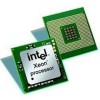Intel X5472 Specification Update - Page 25
Pending x87 FPU Exceptions #MF Following STI May Be Serviced
 |
UPC - 735858201551
View all Intel X5472 manuals
Add to My Manuals
Save this manual to your list of manuals |
Page 25 highlights
not do an End of Interrupt (EOI) the bit for the vector will be left set in the in-service register and mask all interrupts at the same or lower priority. Workaround: Any vector programmed into an LVT entry must have an ISR associated with it, even if that vector was programmed as masked. This ISR routine must do an EOI to clear any unexpected interrupts that may occur. The ISR associated with the spurious vector does not generate an EOI, therefore the spurious vector should not be used when writing the LVT. Status: For the steppings affected, see the Summary Tables of Changes. AX26. Pending x87 FPU Exceptions (#MF) Following STI May Be Serviced Before Higher Priority Interrupts Problem: Interrupts that are pending prior to the execution of the STI (Set Interrupt Flag) instruction are normally serviced immediately after the instruction following the STI. An exception to this is if the following instruction triggers a #MF. In this situation, the interrupt should be serviced before the #MF. Because of this erratum, if following STI, an instruction that triggers a #MF is executed while STPCLK#, Enhanced Intel SpeedStep Technology transitions or Thermal Monitor events occur, the pending #MF may be serviced before higher priority interrupts. Implication: Software may observe #MF being serviced before higher priority interrupts. Workaround: None identified. Status: For the steppings affected, see the Summary Tables of Changes. AX27. VERW/VERR/LSL/LAR Instructions May Unexpectedly Update the Last Exception Record (LER) MSR Problem: The LER MSR may be unexpectedly updated, if the resultant value of the Zero Flag (ZF) is zero after executing the following instructions 1. VERR (ZF=0 indicates unsuccessful segment read verification) 2. VERW (ZF=0 indicates unsuccessful segment write verification) 3. LAR (ZF=0 indicates unsuccessful access rights load) 4. LSL (ZF=0 indicates unsuccessful segment limit load) Implication: The value of the LER MSR may be inaccurate if VERW/VERR/LSL/LAR instructions are executed after the occurrence of an exception. Workaround: Software exception handlers that rely on the LER MSR value should read the LER MSR before executing VERW/VERR/LSL/LAR instructions. Status: For the steppings affected, see the Summary Tables of Changes. AX28. Problem: Implication: INIT Does Not Clear Global Entries in the TLB INIT may not flush a TLB entry when: • The processor is in protected mode with paging enabled and the page global enable flag is set (PGE bit of CR4 register) • G bit for the page table entry is set • TLB entry is present in TLB when INIT occurs Software may encounter unexpected page fault or incorrect address translation due to a TLB entry erroneously left in TLB after INIT. 25 Intel® Xeon® Processor 5400 Series Specification Update















